Developing Manager: Analysis of Leadership, Management and Skills
VerifiedAdded on 2023/04/10
|21
|4658
|195
Report
AI Summary
This report provides a comprehensive analysis of leadership and management principles within the context of the travel and tourism industry. It begins by comparing various management styles, including autocratic, consultative, persuasive, democratic, chaotic, and laissez-faire, and discusses their implications for organizational effectiveness. The report then delves into the characteristics of effective leaders, emphasizing empathy, consistency, honesty, direction, communication, and flexibility. It also evaluates the communication process in travel and tourism, highlighting the importance of sender-receiver dynamics, internal organizational communication, and on-field communication for ensuring successful operations. Furthermore, the report examines organizational culture and change, addressing key aspects such as general changes, employee group dynamics, and cultural shifts. The report also includes a SWOT analysis of a hotel, discusses management skill performance, and explores how managerial and personal skills support career development, including setting objectives and motivating teams. The report concludes with the analysis of career development and personal needs, and making recommendations for improvement.
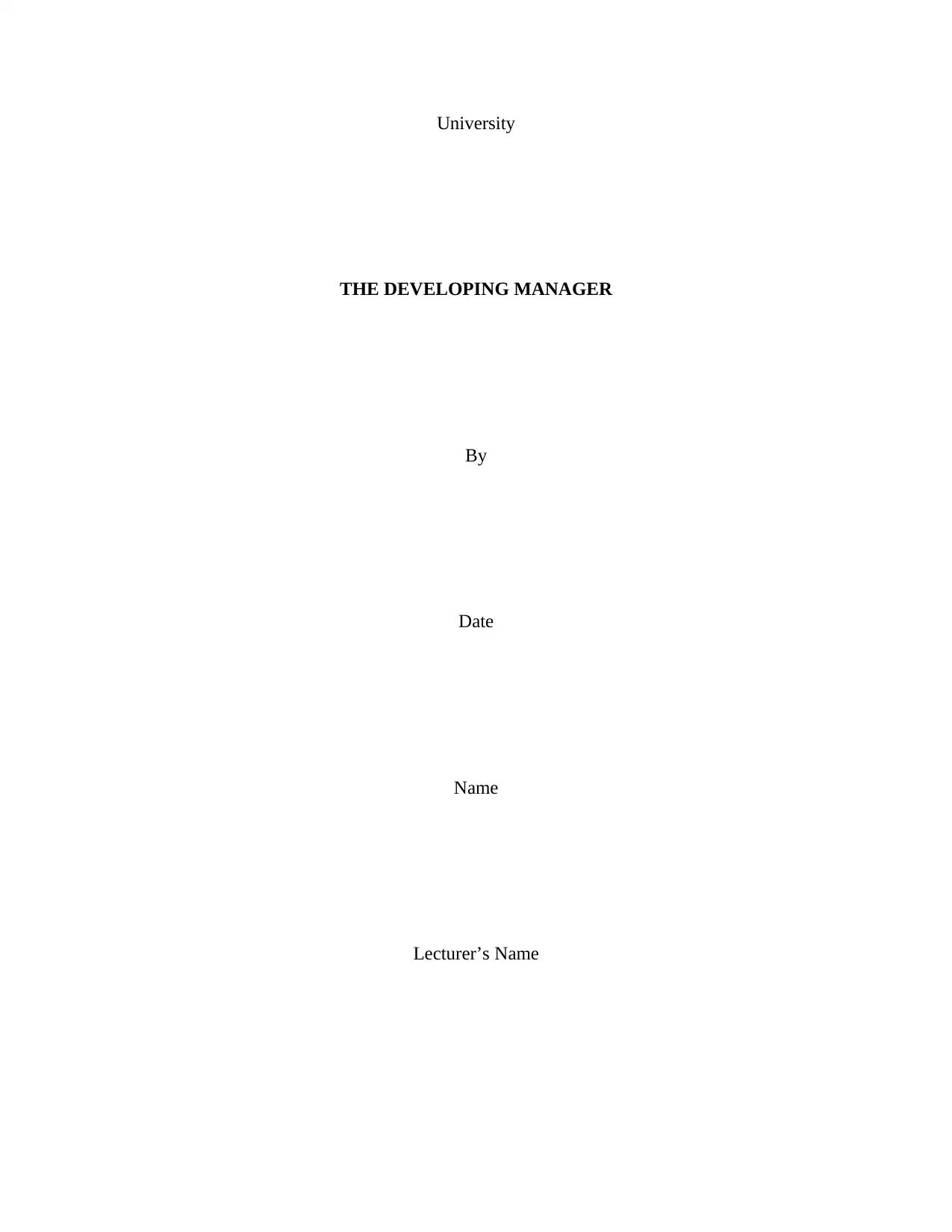
University
THE DEVELOPING MANAGER
By
Date
Name
Lecturer’s Name
THE DEVELOPING MANAGER
By
Date
Name
Lecturer’s Name
Paraphrase This Document
Need a fresh take? Get an instant paraphrase of this document with our AI Paraphraser
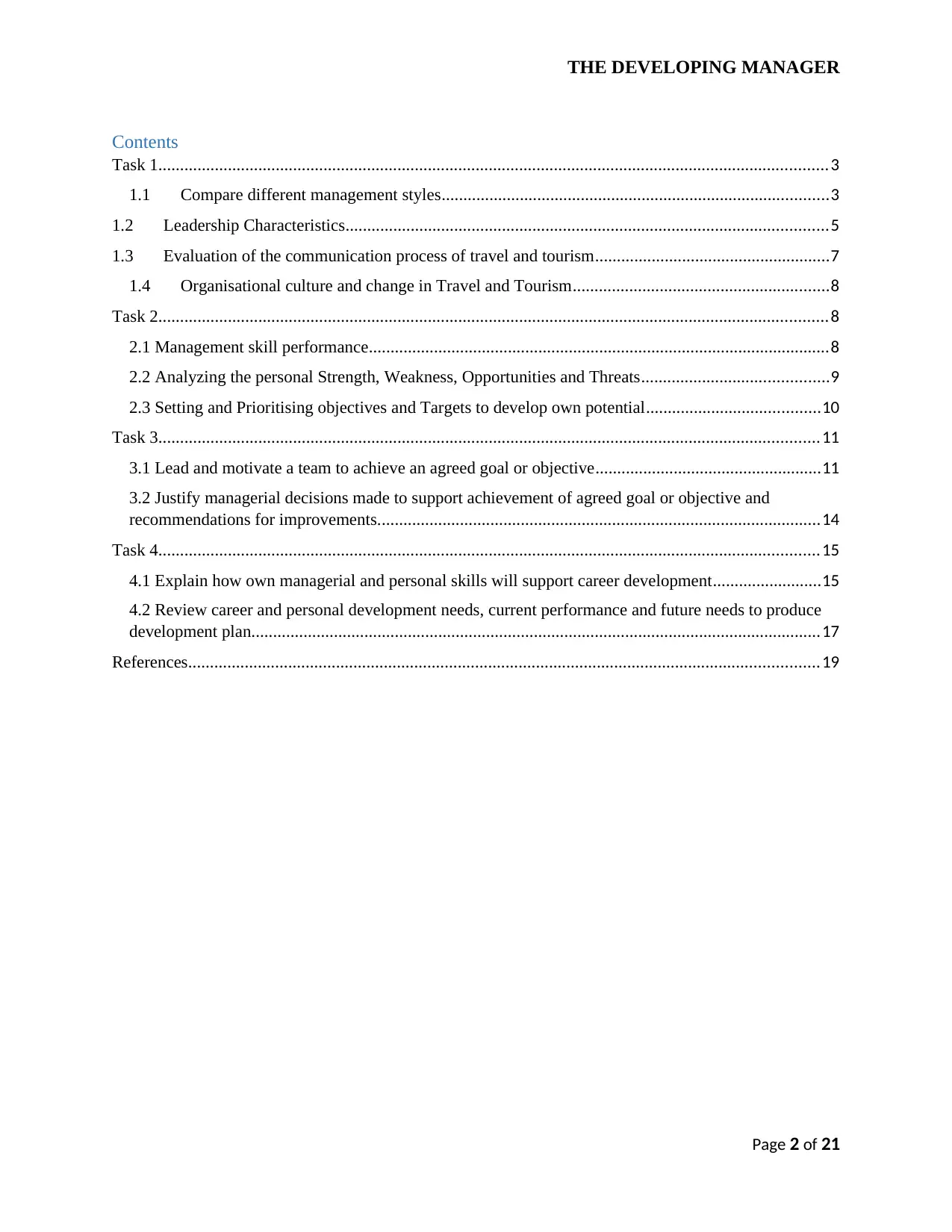
THE DEVELOPING MANAGER
Contents
Task 1..........................................................................................................................................................3
1.1 Compare different management styles.........................................................................................3
1.2 Leadership Characteristics...............................................................................................................5
1.3 Evaluation of the communication process of travel and tourism......................................................7
1.4 Organisational culture and change in Travel and Tourism...........................................................8
Task 2..........................................................................................................................................................8
2.1 Management skill performance..........................................................................................................8
2.2 Analyzing the personal Strength, Weakness, Opportunities and Threats...........................................9
2.3 Setting and Prioritising objectives and Targets to develop own potential........................................10
Task 3........................................................................................................................................................11
3.1 Lead and motivate a team to achieve an agreed goal or objective....................................................11
3.2 Justify managerial decisions made to support achievement of agreed goal or objective and
recommendations for improvements......................................................................................................14
Task 4........................................................................................................................................................15
4.1 Explain how own managerial and personal skills will support career development.........................15
4.2 Review career and personal development needs, current performance and future needs to produce
development plan...................................................................................................................................17
References.................................................................................................................................................19
Page 2 of 21
Contents
Task 1..........................................................................................................................................................3
1.1 Compare different management styles.........................................................................................3
1.2 Leadership Characteristics...............................................................................................................5
1.3 Evaluation of the communication process of travel and tourism......................................................7
1.4 Organisational culture and change in Travel and Tourism...........................................................8
Task 2..........................................................................................................................................................8
2.1 Management skill performance..........................................................................................................8
2.2 Analyzing the personal Strength, Weakness, Opportunities and Threats...........................................9
2.3 Setting and Prioritising objectives and Targets to develop own potential........................................10
Task 3........................................................................................................................................................11
3.1 Lead and motivate a team to achieve an agreed goal or objective....................................................11
3.2 Justify managerial decisions made to support achievement of agreed goal or objective and
recommendations for improvements......................................................................................................14
Task 4........................................................................................................................................................15
4.1 Explain how own managerial and personal skills will support career development.........................15
4.2 Review career and personal development needs, current performance and future needs to produce
development plan...................................................................................................................................17
References.................................................................................................................................................19
Page 2 of 21
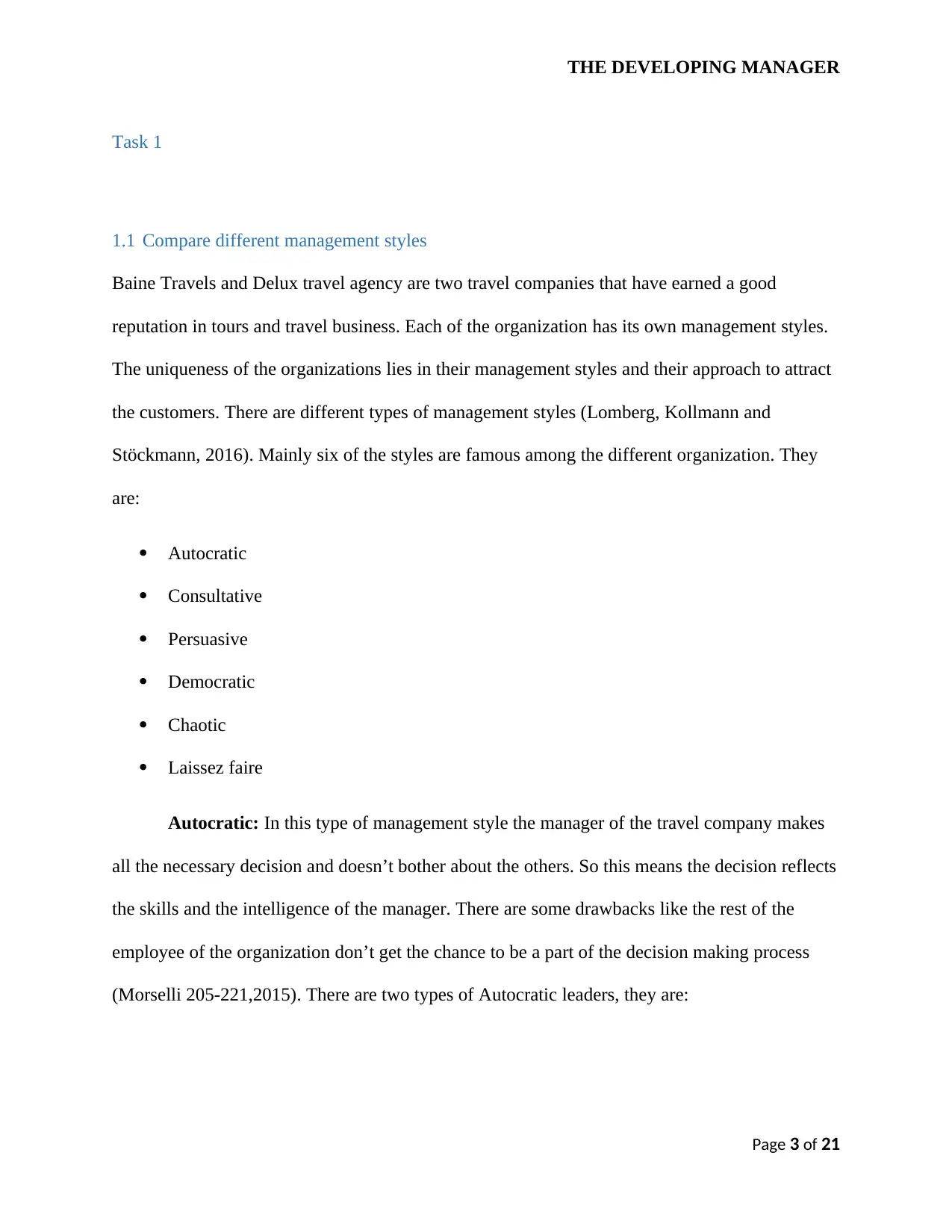
THE DEVELOPING MANAGER
Task 1
1.1 Compare different management styles
Baine Travels and Delux travel agency are two travel companies that have earned a good
reputation in tours and travel business. Each of the organization has its own management styles.
The uniqueness of the organizations lies in their management styles and their approach to attract
the customers. There are different types of management styles (Lomberg, Kollmann and
Stöckmann, 2016). Mainly six of the styles are famous among the different organization. They
are:
Autocratic
Consultative
Persuasive
Democratic
Chaotic
Laissez faire
Autocratic: In this type of management style the manager of the travel company makes
all the necessary decision and doesn’t bother about the others. So this means the decision reflects
the skills and the intelligence of the manager. There are some drawbacks like the rest of the
employee of the organization don’t get the chance to be a part of the decision making process
(Morselli 205-221,2015). There are two types of Autocratic leaders, they are:
Page 3 of 21
Task 1
1.1 Compare different management styles
Baine Travels and Delux travel agency are two travel companies that have earned a good
reputation in tours and travel business. Each of the organization has its own management styles.
The uniqueness of the organizations lies in their management styles and their approach to attract
the customers. There are different types of management styles (Lomberg, Kollmann and
Stöckmann, 2016). Mainly six of the styles are famous among the different organization. They
are:
Autocratic
Consultative
Persuasive
Democratic
Chaotic
Laissez faire
Autocratic: In this type of management style the manager of the travel company makes
all the necessary decision and doesn’t bother about the others. So this means the decision reflects
the skills and the intelligence of the manager. There are some drawbacks like the rest of the
employee of the organization don’t get the chance to be a part of the decision making process
(Morselli 205-221,2015). There are two types of Autocratic leaders, they are:
Page 3 of 21
⊘ This is a preview!⊘
Do you want full access?
Subscribe today to unlock all pages.

Trusted by 1+ million students worldwide
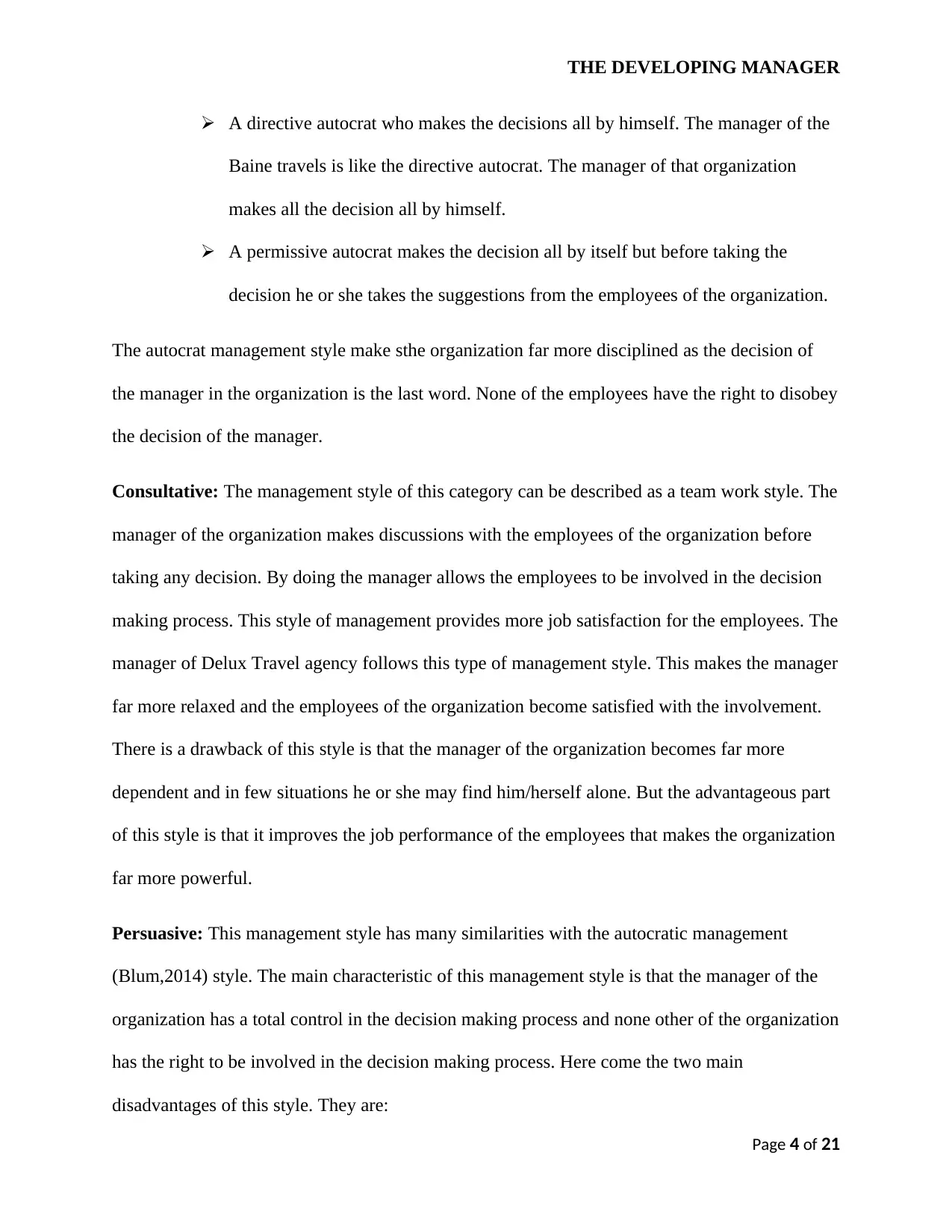
THE DEVELOPING MANAGER
A directive autocrat who makes the decisions all by himself. The manager of the
Baine travels is like the directive autocrat. The manager of that organization
makes all the decision all by himself.
A permissive autocrat makes the decision all by itself but before taking the
decision he or she takes the suggestions from the employees of the organization.
The autocrat management style make sthe organization far more disciplined as the decision of
the manager in the organization is the last word. None of the employees have the right to disobey
the decision of the manager.
Consultative: The management style of this category can be described as a team work style. The
manager of the organization makes discussions with the employees of the organization before
taking any decision. By doing the manager allows the employees to be involved in the decision
making process. This style of management provides more job satisfaction for the employees. The
manager of Delux Travel agency follows this type of management style. This makes the manager
far more relaxed and the employees of the organization become satisfied with the involvement.
There is a drawback of this style is that the manager of the organization becomes far more
dependent and in few situations he or she may find him/herself alone. But the advantageous part
of this style is that it improves the job performance of the employees that makes the organization
far more powerful.
Persuasive: This management style has many similarities with the autocratic management
(Blum,2014) style. The main characteristic of this management style is that the manager of the
organization has a total control in the decision making process and none other of the organization
has the right to be involved in the decision making process. Here come the two main
disadvantages of this style. They are:
Page 4 of 21
A directive autocrat who makes the decisions all by himself. The manager of the
Baine travels is like the directive autocrat. The manager of that organization
makes all the decision all by himself.
A permissive autocrat makes the decision all by itself but before taking the
decision he or she takes the suggestions from the employees of the organization.
The autocrat management style make sthe organization far more disciplined as the decision of
the manager in the organization is the last word. None of the employees have the right to disobey
the decision of the manager.
Consultative: The management style of this category can be described as a team work style. The
manager of the organization makes discussions with the employees of the organization before
taking any decision. By doing the manager allows the employees to be involved in the decision
making process. This style of management provides more job satisfaction for the employees. The
manager of Delux Travel agency follows this type of management style. This makes the manager
far more relaxed and the employees of the organization become satisfied with the involvement.
There is a drawback of this style is that the manager of the organization becomes far more
dependent and in few situations he or she may find him/herself alone. But the advantageous part
of this style is that it improves the job performance of the employees that makes the organization
far more powerful.
Persuasive: This management style has many similarities with the autocratic management
(Blum,2014) style. The main characteristic of this management style is that the manager of the
organization has a total control in the decision making process and none other of the organization
has the right to be involved in the decision making process. Here come the two main
disadvantages of this style. They are:
Page 4 of 21
Paraphrase This Document
Need a fresh take? Get an instant paraphrase of this document with our AI Paraphraser
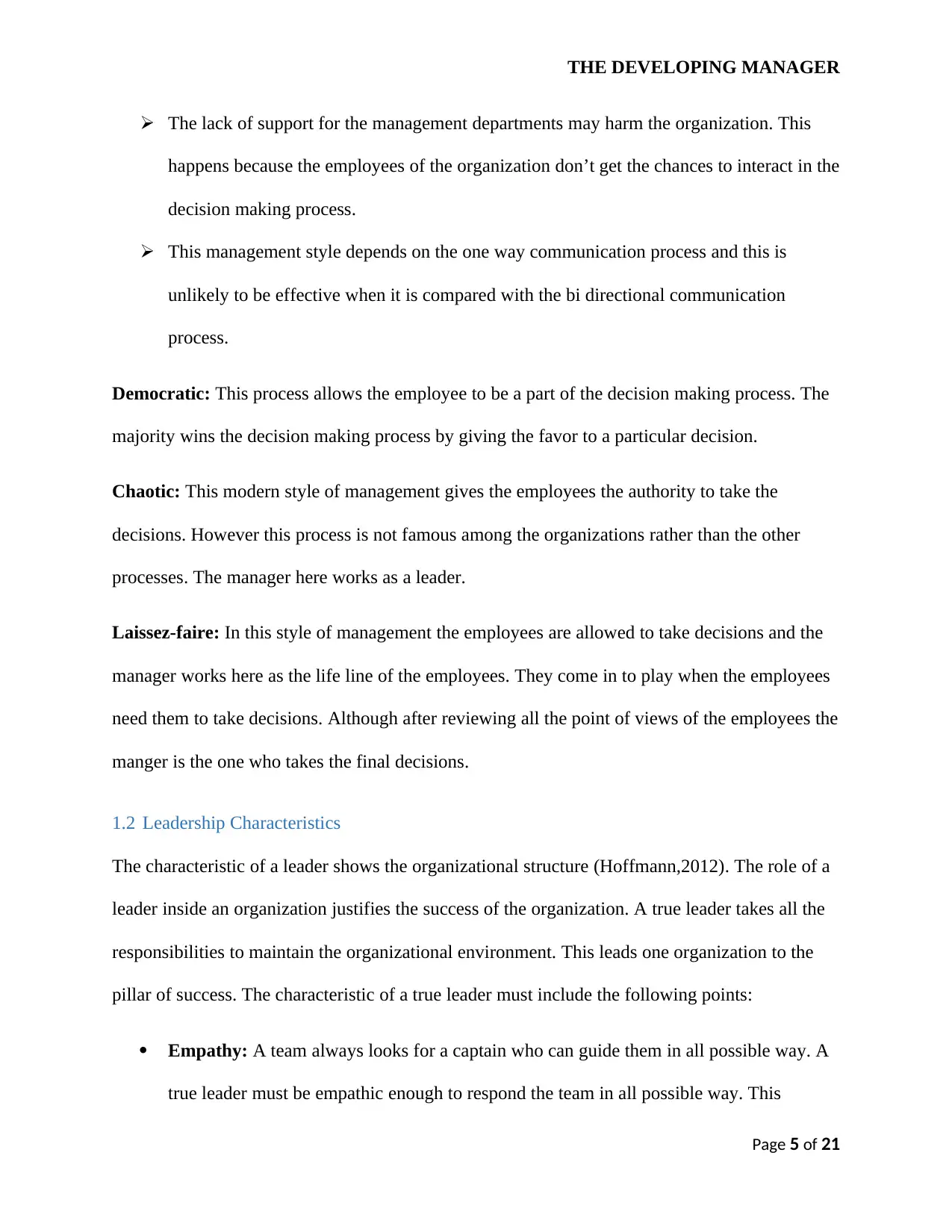
THE DEVELOPING MANAGER
The lack of support for the management departments may harm the organization. This
happens because the employees of the organization don’t get the chances to interact in the
decision making process.
This management style depends on the one way communication process and this is
unlikely to be effective when it is compared with the bi directional communication
process.
Democratic: This process allows the employee to be a part of the decision making process. The
majority wins the decision making process by giving the favor to a particular decision.
Chaotic: This modern style of management gives the employees the authority to take the
decisions. However this process is not famous among the organizations rather than the other
processes. The manager here works as a leader.
Laissez-faire: In this style of management the employees are allowed to take decisions and the
manager works here as the life line of the employees. They come in to play when the employees
need them to take decisions. Although after reviewing all the point of views of the employees the
manger is the one who takes the final decisions.
1.2 Leadership Characteristics
The characteristic of a leader shows the organizational structure (Hoffmann,2012). The role of a
leader inside an organization justifies the success of the organization. A true leader takes all the
responsibilities to maintain the organizational environment. This leads one organization to the
pillar of success. The characteristic of a true leader must include the following points:
Empathy: A team always looks for a captain who can guide them in all possible way. A
true leader must be empathic enough to respond the team in all possible way. This
Page 5 of 21
The lack of support for the management departments may harm the organization. This
happens because the employees of the organization don’t get the chances to interact in the
decision making process.
This management style depends on the one way communication process and this is
unlikely to be effective when it is compared with the bi directional communication
process.
Democratic: This process allows the employee to be a part of the decision making process. The
majority wins the decision making process by giving the favor to a particular decision.
Chaotic: This modern style of management gives the employees the authority to take the
decisions. However this process is not famous among the organizations rather than the other
processes. The manager here works as a leader.
Laissez-faire: In this style of management the employees are allowed to take decisions and the
manager works here as the life line of the employees. They come in to play when the employees
need them to take decisions. Although after reviewing all the point of views of the employees the
manger is the one who takes the final decisions.
1.2 Leadership Characteristics
The characteristic of a leader shows the organizational structure (Hoffmann,2012). The role of a
leader inside an organization justifies the success of the organization. A true leader takes all the
responsibilities to maintain the organizational environment. This leads one organization to the
pillar of success. The characteristic of a true leader must include the following points:
Empathy: A team always looks for a captain who can guide them in all possible way. A
true leader must be empathic enough to respond the team in all possible way. This
Page 5 of 21
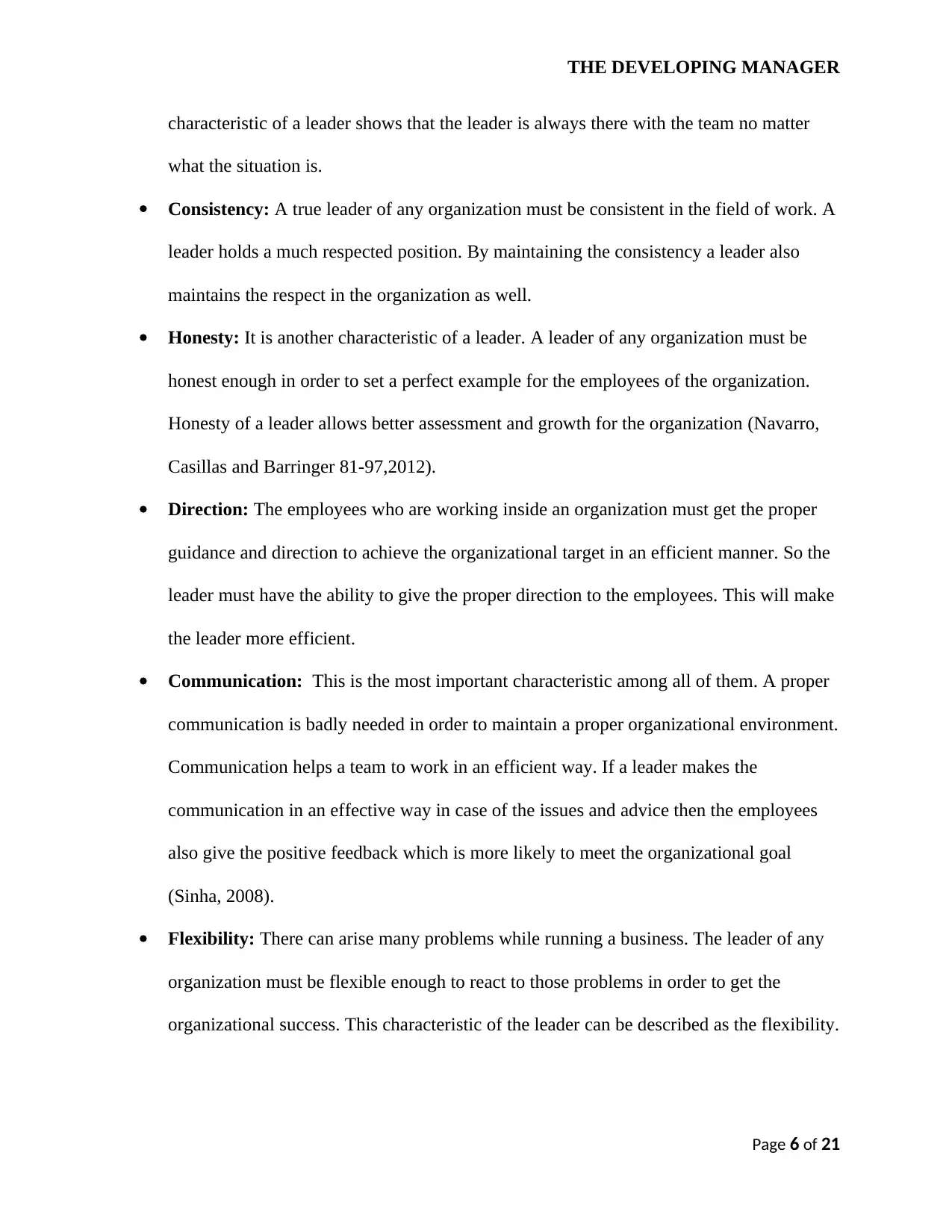
THE DEVELOPING MANAGER
characteristic of a leader shows that the leader is always there with the team no matter
what the situation is.
Consistency: A true leader of any organization must be consistent in the field of work. A
leader holds a much respected position. By maintaining the consistency a leader also
maintains the respect in the organization as well.
Honesty: It is another characteristic of a leader. A leader of any organization must be
honest enough in order to set a perfect example for the employees of the organization.
Honesty of a leader allows better assessment and growth for the organization (Navarro,
Casillas and Barringer 81-97,2012).
Direction: The employees who are working inside an organization must get the proper
guidance and direction to achieve the organizational target in an efficient manner. So the
leader must have the ability to give the proper direction to the employees. This will make
the leader more efficient.
Communication: This is the most important characteristic among all of them. A proper
communication is badly needed in order to maintain a proper organizational environment.
Communication helps a team to work in an efficient way. If a leader makes the
communication in an effective way in case of the issues and advice then the employees
also give the positive feedback which is more likely to meet the organizational goal
(Sinha, 2008).
Flexibility: There can arise many problems while running a business. The leader of any
organization must be flexible enough to react to those problems in order to get the
organizational success. This characteristic of the leader can be described as the flexibility.
Page 6 of 21
characteristic of a leader shows that the leader is always there with the team no matter
what the situation is.
Consistency: A true leader of any organization must be consistent in the field of work. A
leader holds a much respected position. By maintaining the consistency a leader also
maintains the respect in the organization as well.
Honesty: It is another characteristic of a leader. A leader of any organization must be
honest enough in order to set a perfect example for the employees of the organization.
Honesty of a leader allows better assessment and growth for the organization (Navarro,
Casillas and Barringer 81-97,2012).
Direction: The employees who are working inside an organization must get the proper
guidance and direction to achieve the organizational target in an efficient manner. So the
leader must have the ability to give the proper direction to the employees. This will make
the leader more efficient.
Communication: This is the most important characteristic among all of them. A proper
communication is badly needed in order to maintain a proper organizational environment.
Communication helps a team to work in an efficient way. If a leader makes the
communication in an effective way in case of the issues and advice then the employees
also give the positive feedback which is more likely to meet the organizational goal
(Sinha, 2008).
Flexibility: There can arise many problems while running a business. The leader of any
organization must be flexible enough to react to those problems in order to get the
organizational success. This characteristic of the leader can be described as the flexibility.
Page 6 of 21
⊘ This is a preview!⊘
Do you want full access?
Subscribe today to unlock all pages.

Trusted by 1+ million students worldwide
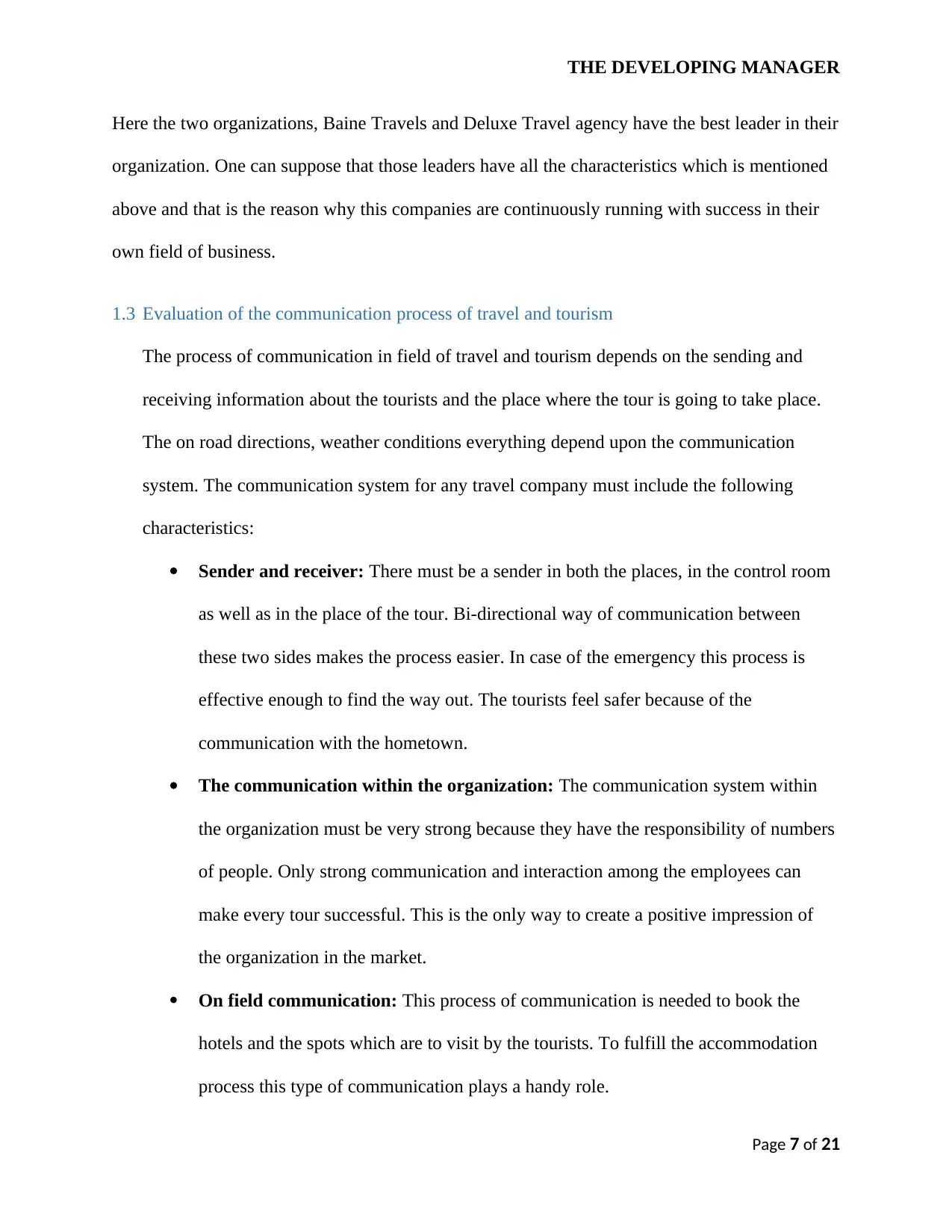
THE DEVELOPING MANAGER
Here the two organizations, Baine Travels and Deluxe Travel agency have the best leader in their
organization. One can suppose that those leaders have all the characteristics which is mentioned
above and that is the reason why this companies are continuously running with success in their
own field of business.
1.3 Evaluation of the communication process of travel and tourism
The process of communication in field of travel and tourism depends on the sending and
receiving information about the tourists and the place where the tour is going to take place.
The on road directions, weather conditions everything depend upon the communication
system. The communication system for any travel company must include the following
characteristics:
Sender and receiver: There must be a sender in both the places, in the control room
as well as in the place of the tour. Bi-directional way of communication between
these two sides makes the process easier. In case of the emergency this process is
effective enough to find the way out. The tourists feel safer because of the
communication with the hometown.
The communication within the organization: The communication system within
the organization must be very strong because they have the responsibility of numbers
of people. Only strong communication and interaction among the employees can
make every tour successful. This is the only way to create a positive impression of
the organization in the market.
On field communication: This process of communication is needed to book the
hotels and the spots which are to visit by the tourists. To fulfill the accommodation
process this type of communication plays a handy role.
Page 7 of 21
Here the two organizations, Baine Travels and Deluxe Travel agency have the best leader in their
organization. One can suppose that those leaders have all the characteristics which is mentioned
above and that is the reason why this companies are continuously running with success in their
own field of business.
1.3 Evaluation of the communication process of travel and tourism
The process of communication in field of travel and tourism depends on the sending and
receiving information about the tourists and the place where the tour is going to take place.
The on road directions, weather conditions everything depend upon the communication
system. The communication system for any travel company must include the following
characteristics:
Sender and receiver: There must be a sender in both the places, in the control room
as well as in the place of the tour. Bi-directional way of communication between
these two sides makes the process easier. In case of the emergency this process is
effective enough to find the way out. The tourists feel safer because of the
communication with the hometown.
The communication within the organization: The communication system within
the organization must be very strong because they have the responsibility of numbers
of people. Only strong communication and interaction among the employees can
make every tour successful. This is the only way to create a positive impression of
the organization in the market.
On field communication: This process of communication is needed to book the
hotels and the spots which are to visit by the tourists. To fulfill the accommodation
process this type of communication plays a handy role.
Page 7 of 21
Paraphrase This Document
Need a fresh take? Get an instant paraphrase of this document with our AI Paraphraser
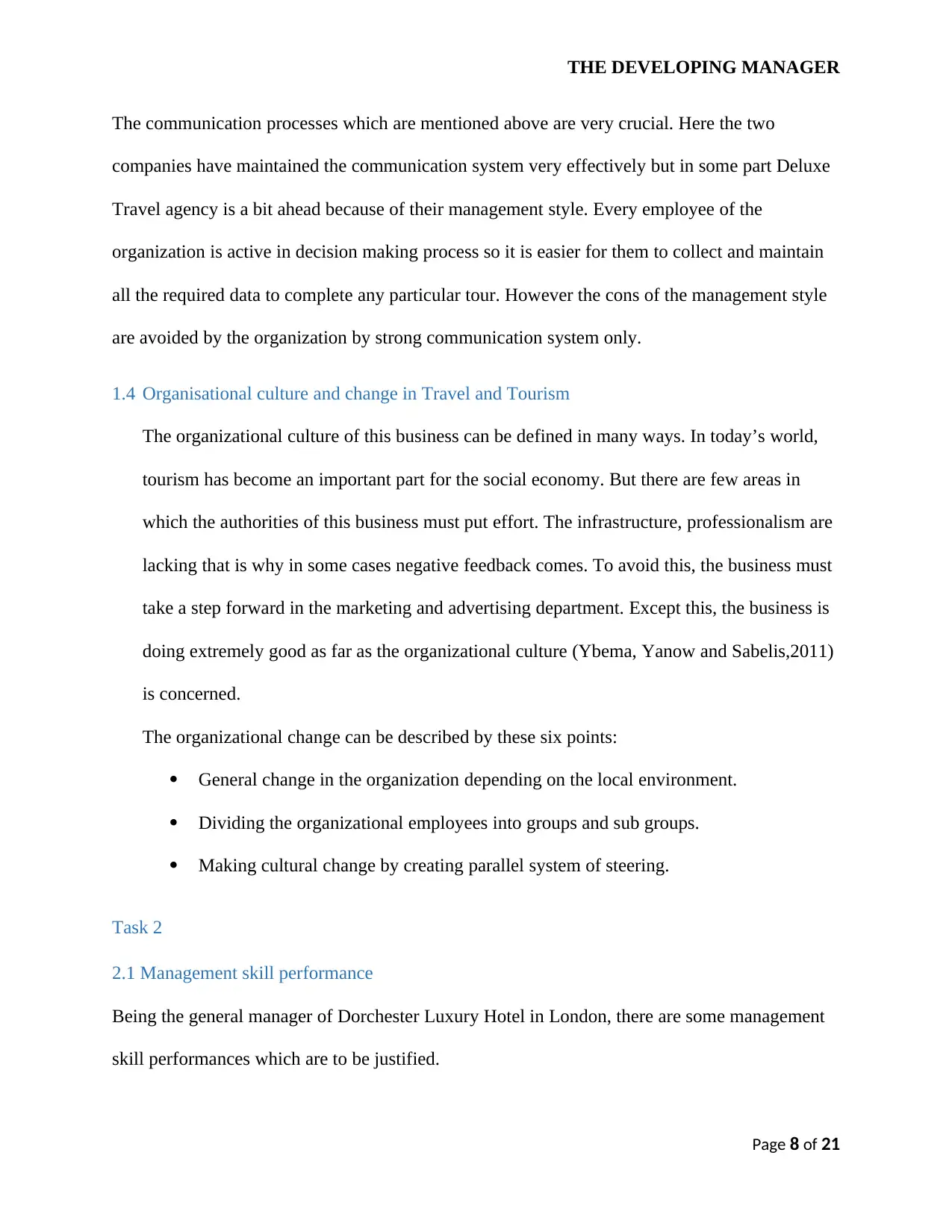
THE DEVELOPING MANAGER
The communication processes which are mentioned above are very crucial. Here the two
companies have maintained the communication system very effectively but in some part Deluxe
Travel agency is a bit ahead because of their management style. Every employee of the
organization is active in decision making process so it is easier for them to collect and maintain
all the required data to complete any particular tour. However the cons of the management style
are avoided by the organization by strong communication system only.
1.4 Organisational culture and change in Travel and Tourism
The organizational culture of this business can be defined in many ways. In today’s world,
tourism has become an important part for the social economy. But there are few areas in
which the authorities of this business must put effort. The infrastructure, professionalism are
lacking that is why in some cases negative feedback comes. To avoid this, the business must
take a step forward in the marketing and advertising department. Except this, the business is
doing extremely good as far as the organizational culture (Ybema, Yanow and Sabelis,2011)
is concerned.
The organizational change can be described by these six points:
General change in the organization depending on the local environment.
Dividing the organizational employees into groups and sub groups.
Making cultural change by creating parallel system of steering.
Task 2
2.1 Management skill performance
Being the general manager of Dorchester Luxury Hotel in London, there are some management
skill performances which are to be justified.
Page 8 of 21
The communication processes which are mentioned above are very crucial. Here the two
companies have maintained the communication system very effectively but in some part Deluxe
Travel agency is a bit ahead because of their management style. Every employee of the
organization is active in decision making process so it is easier for them to collect and maintain
all the required data to complete any particular tour. However the cons of the management style
are avoided by the organization by strong communication system only.
1.4 Organisational culture and change in Travel and Tourism
The organizational culture of this business can be defined in many ways. In today’s world,
tourism has become an important part for the social economy. But there are few areas in
which the authorities of this business must put effort. The infrastructure, professionalism are
lacking that is why in some cases negative feedback comes. To avoid this, the business must
take a step forward in the marketing and advertising department. Except this, the business is
doing extremely good as far as the organizational culture (Ybema, Yanow and Sabelis,2011)
is concerned.
The organizational change can be described by these six points:
General change in the organization depending on the local environment.
Dividing the organizational employees into groups and sub groups.
Making cultural change by creating parallel system of steering.
Task 2
2.1 Management skill performance
Being the general manager of Dorchester Luxury Hotel in London, there are some management
skill performances which are to be justified.
Page 8 of 21
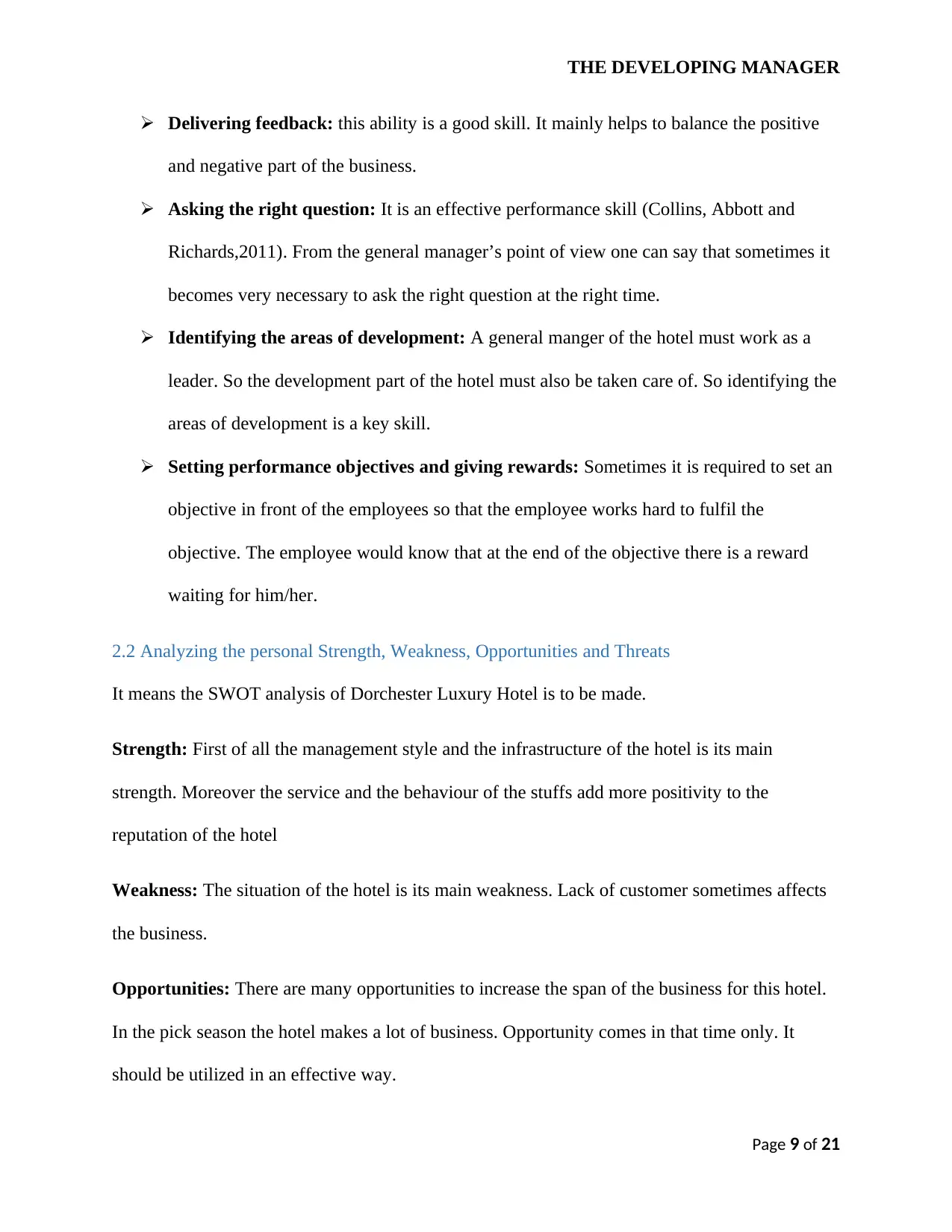
THE DEVELOPING MANAGER
Delivering feedback: this ability is a good skill. It mainly helps to balance the positive
and negative part of the business.
Asking the right question: It is an effective performance skill (Collins, Abbott and
Richards,2011). From the general manager’s point of view one can say that sometimes it
becomes very necessary to ask the right question at the right time.
Identifying the areas of development: A general manger of the hotel must work as a
leader. So the development part of the hotel must also be taken care of. So identifying the
areas of development is a key skill.
Setting performance objectives and giving rewards: Sometimes it is required to set an
objective in front of the employees so that the employee works hard to fulfil the
objective. The employee would know that at the end of the objective there is a reward
waiting for him/her.
2.2 Analyzing the personal Strength, Weakness, Opportunities and Threats
It means the SWOT analysis of Dorchester Luxury Hotel is to be made.
Strength: First of all the management style and the infrastructure of the hotel is its main
strength. Moreover the service and the behaviour of the stuffs add more positivity to the
reputation of the hotel
Weakness: The situation of the hotel is its main weakness. Lack of customer sometimes affects
the business.
Opportunities: There are many opportunities to increase the span of the business for this hotel.
In the pick season the hotel makes a lot of business. Opportunity comes in that time only. It
should be utilized in an effective way.
Page 9 of 21
Delivering feedback: this ability is a good skill. It mainly helps to balance the positive
and negative part of the business.
Asking the right question: It is an effective performance skill (Collins, Abbott and
Richards,2011). From the general manager’s point of view one can say that sometimes it
becomes very necessary to ask the right question at the right time.
Identifying the areas of development: A general manger of the hotel must work as a
leader. So the development part of the hotel must also be taken care of. So identifying the
areas of development is a key skill.
Setting performance objectives and giving rewards: Sometimes it is required to set an
objective in front of the employees so that the employee works hard to fulfil the
objective. The employee would know that at the end of the objective there is a reward
waiting for him/her.
2.2 Analyzing the personal Strength, Weakness, Opportunities and Threats
It means the SWOT analysis of Dorchester Luxury Hotel is to be made.
Strength: First of all the management style and the infrastructure of the hotel is its main
strength. Moreover the service and the behaviour of the stuffs add more positivity to the
reputation of the hotel
Weakness: The situation of the hotel is its main weakness. Lack of customer sometimes affects
the business.
Opportunities: There are many opportunities to increase the span of the business for this hotel.
In the pick season the hotel makes a lot of business. Opportunity comes in that time only. It
should be utilized in an effective way.
Page 9 of 21
⊘ This is a preview!⊘
Do you want full access?
Subscribe today to unlock all pages.

Trusted by 1+ million students worldwide
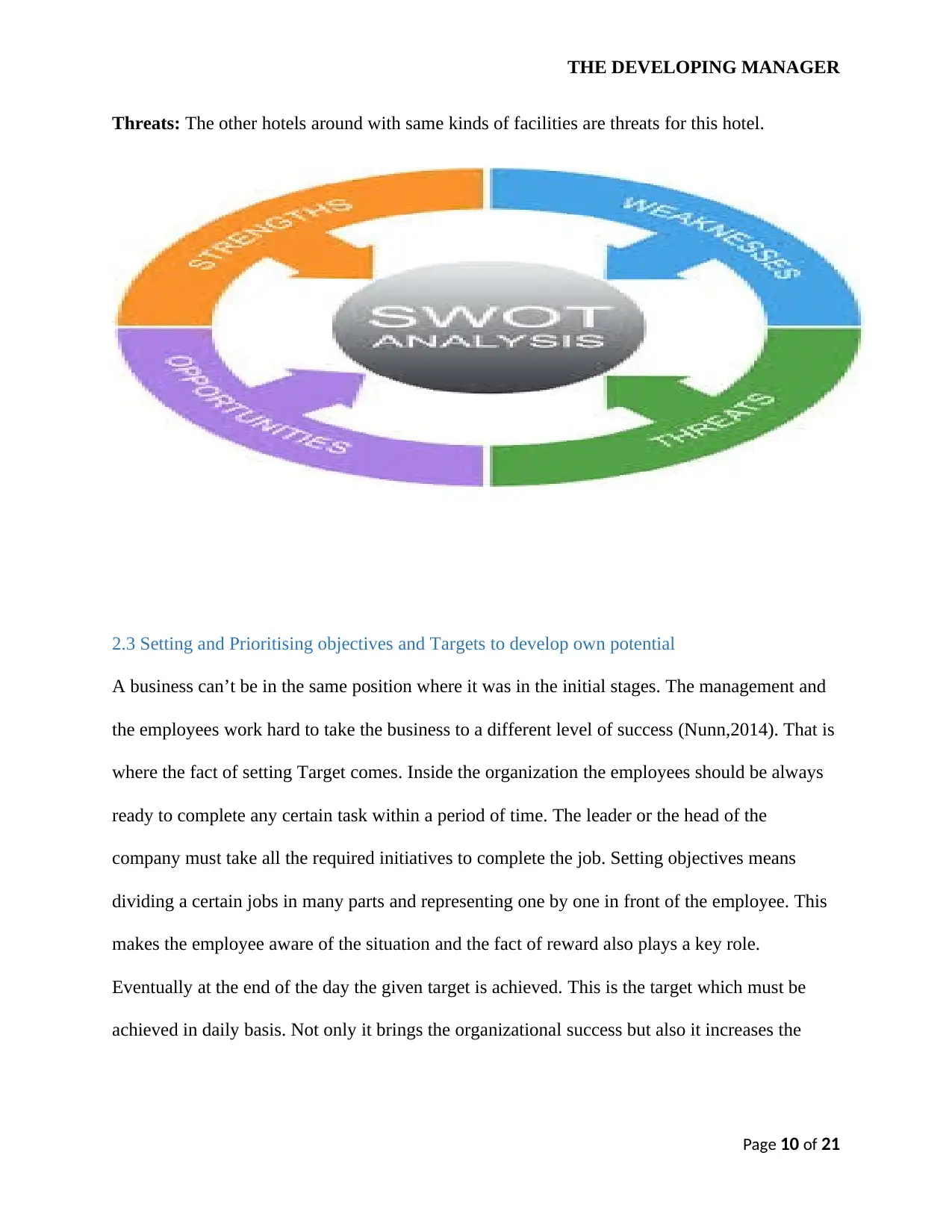
THE DEVELOPING MANAGER
Threats: The other hotels around with same kinds of facilities are threats for this hotel.
2.3 Setting and Prioritising objectives and Targets to develop own potential
A business can’t be in the same position where it was in the initial stages. The management and
the employees work hard to take the business to a different level of success (Nunn,2014). That is
where the fact of setting Target comes. Inside the organization the employees should be always
ready to complete any certain task within a period of time. The leader or the head of the
company must take all the required initiatives to complete the job. Setting objectives means
dividing a certain jobs in many parts and representing one by one in front of the employee. This
makes the employee aware of the situation and the fact of reward also plays a key role.
Eventually at the end of the day the given target is achieved. This is the target which must be
achieved in daily basis. Not only it brings the organizational success but also it increases the
Page 10 of 21
Threats: The other hotels around with same kinds of facilities are threats for this hotel.
2.3 Setting and Prioritising objectives and Targets to develop own potential
A business can’t be in the same position where it was in the initial stages. The management and
the employees work hard to take the business to a different level of success (Nunn,2014). That is
where the fact of setting Target comes. Inside the organization the employees should be always
ready to complete any certain task within a period of time. The leader or the head of the
company must take all the required initiatives to complete the job. Setting objectives means
dividing a certain jobs in many parts and representing one by one in front of the employee. This
makes the employee aware of the situation and the fact of reward also plays a key role.
Eventually at the end of the day the given target is achieved. This is the target which must be
achieved in daily basis. Not only it brings the organizational success but also it increases the
Page 10 of 21
Paraphrase This Document
Need a fresh take? Get an instant paraphrase of this document with our AI Paraphraser
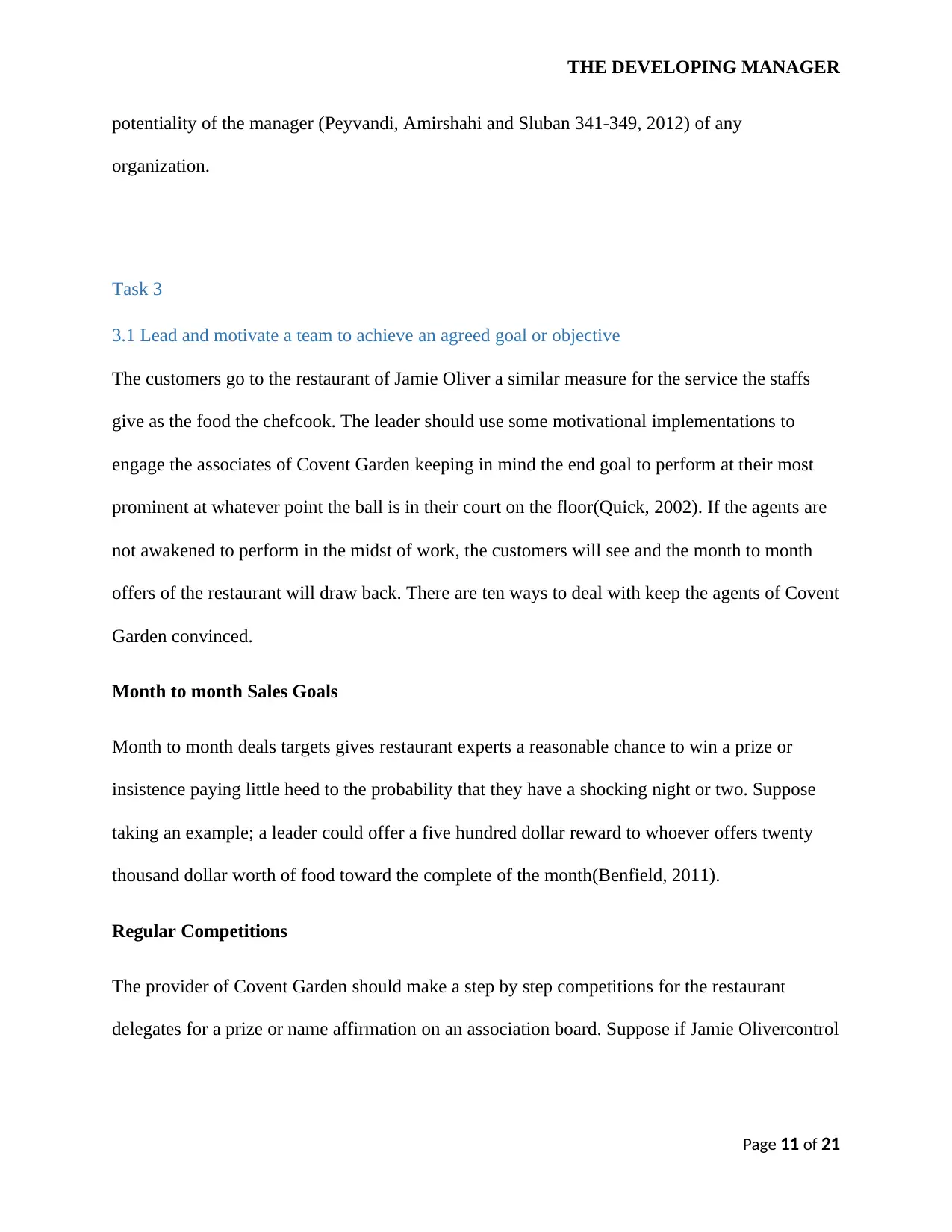
THE DEVELOPING MANAGER
potentiality of the manager (Peyvandi, Amirshahi and Sluban 341-349, 2012) of any
organization.
Task 3
3.1 Lead and motivate a team to achieve an agreed goal or objective
The customers go to the restaurant of Jamie Oliver a similar measure for the service the staffs
give as the food the chefcook. The leader should use some motivational implementations to
engage the associates of Covent Garden keeping in mind the end goal to perform at their most
prominent at whatever point the ball is in their court on the floor(Quick, 2002). If the agents are
not awakened to perform in the midst of work, the customers will see and the month to month
offers of the restaurant will draw back. There are ten ways to deal with keep the agents of Covent
Garden convinced.
Month to month Sales Goals
Month to month deals targets gives restaurant experts a reasonable chance to win a prize or
insistence paying little heed to the probability that they have a shocking night or two. Suppose
taking an example; a leader could offer a five hundred dollar reward to whoever offers twenty
thousand dollar worth of food toward the complete of the month(Benfield, 2011).
Regular Competitions
The provider of Covent Garden should make a step by step competitions for the restaurant
delegates for a prize or name affirmation on an association board. Suppose if Jamie Olivercontrol
Page 11 of 21
potentiality of the manager (Peyvandi, Amirshahi and Sluban 341-349, 2012) of any
organization.
Task 3
3.1 Lead and motivate a team to achieve an agreed goal or objective
The customers go to the restaurant of Jamie Oliver a similar measure for the service the staffs
give as the food the chefcook. The leader should use some motivational implementations to
engage the associates of Covent Garden keeping in mind the end goal to perform at their most
prominent at whatever point the ball is in their court on the floor(Quick, 2002). If the agents are
not awakened to perform in the midst of work, the customers will see and the month to month
offers of the restaurant will draw back. There are ten ways to deal with keep the agents of Covent
Garden convinced.
Month to month Sales Goals
Month to month deals targets gives restaurant experts a reasonable chance to win a prize or
insistence paying little heed to the probability that they have a shocking night or two. Suppose
taking an example; a leader could offer a five hundred dollar reward to whoever offers twenty
thousand dollar worth of food toward the complete of the month(Benfield, 2011).
Regular Competitions
The provider of Covent Garden should make a step by step competitions for the restaurant
delegates for a prize or name affirmation on an association board. Suppose if Jamie Olivercontrol
Page 11 of 21
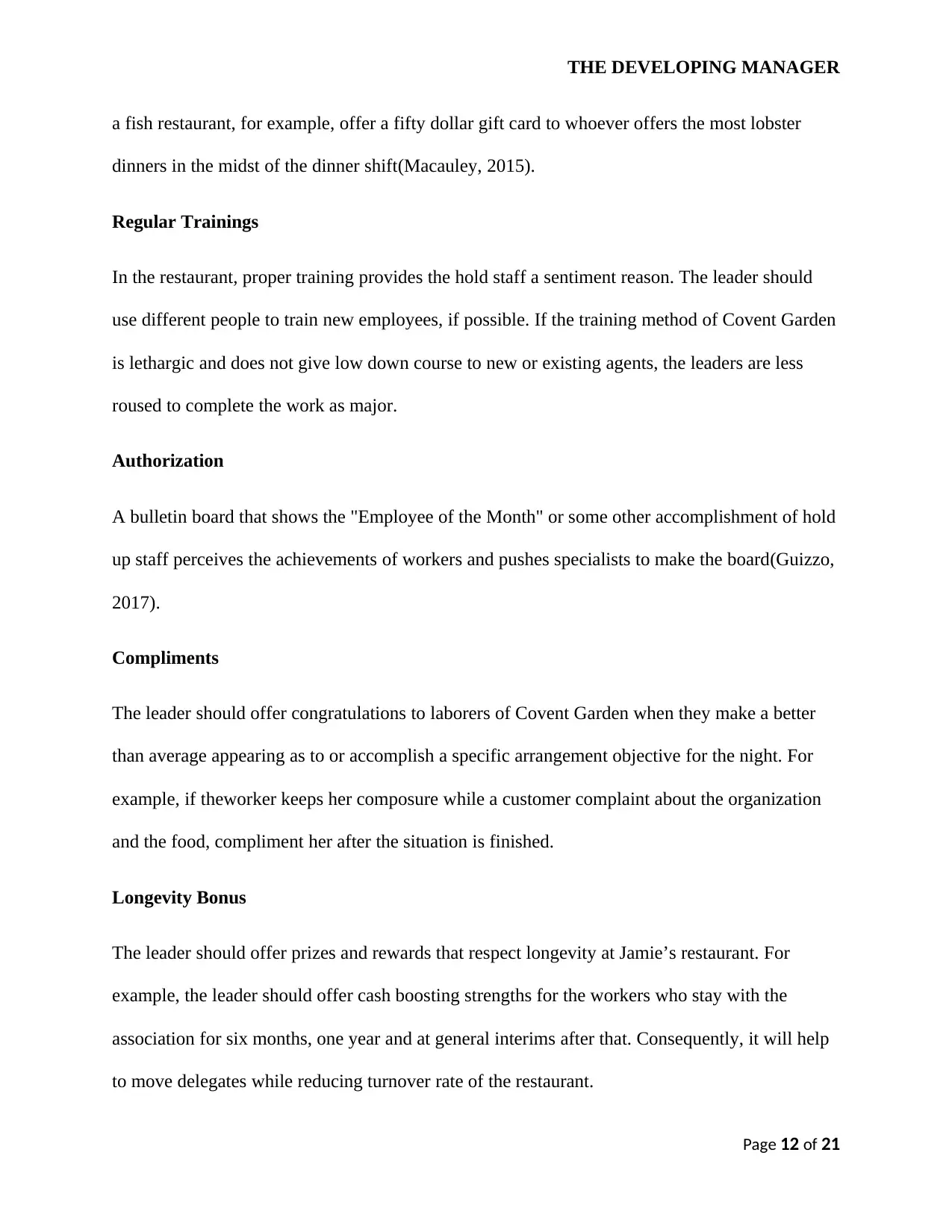
THE DEVELOPING MANAGER
a fish restaurant, for example, offer a fifty dollar gift card to whoever offers the most lobster
dinners in the midst of the dinner shift(Macauley, 2015).
Regular Trainings
In the restaurant, proper training provides the hold staff a sentiment reason. The leader should
use different people to train new employees, if possible. If the training method of Covent Garden
is lethargic and does not give low down course to new or existing agents, the leaders are less
roused to complete the work as major.
Authorization
A bulletin board that shows the "Employee of the Month" or some other accomplishment of hold
up staff perceives the achievements of workers and pushes specialists to make the board(Guizzo,
2017).
Compliments
The leader should offer congratulations to laborers of Covent Garden when they make a better
than average appearing as to or accomplish a specific arrangement objective for the night. For
example, if theworker keeps her composure while a customer complaint about the organization
and the food, compliment her after the situation is finished.
Longevity Bonus
The leader should offer prizes and rewards that respect longevity at Jamie’s restaurant. For
example, the leader should offer cash boosting strengths for the workers who stay with the
association for six months, one year and at general interims after that. Consequently, it will help
to move delegates while reducing turnover rate of the restaurant.
Page 12 of 21
a fish restaurant, for example, offer a fifty dollar gift card to whoever offers the most lobster
dinners in the midst of the dinner shift(Macauley, 2015).
Regular Trainings
In the restaurant, proper training provides the hold staff a sentiment reason. The leader should
use different people to train new employees, if possible. If the training method of Covent Garden
is lethargic and does not give low down course to new or existing agents, the leaders are less
roused to complete the work as major.
Authorization
A bulletin board that shows the "Employee of the Month" or some other accomplishment of hold
up staff perceives the achievements of workers and pushes specialists to make the board(Guizzo,
2017).
Compliments
The leader should offer congratulations to laborers of Covent Garden when they make a better
than average appearing as to or accomplish a specific arrangement objective for the night. For
example, if theworker keeps her composure while a customer complaint about the organization
and the food, compliment her after the situation is finished.
Longevity Bonus
The leader should offer prizes and rewards that respect longevity at Jamie’s restaurant. For
example, the leader should offer cash boosting strengths for the workers who stay with the
association for six months, one year and at general interims after that. Consequently, it will help
to move delegates while reducing turnover rate of the restaurant.
Page 12 of 21
⊘ This is a preview!⊘
Do you want full access?
Subscribe today to unlock all pages.

Trusted by 1+ million students worldwide
1 out of 21
Related Documents
Your All-in-One AI-Powered Toolkit for Academic Success.
+13062052269
info@desklib.com
Available 24*7 on WhatsApp / Email
![[object Object]](/_next/static/media/star-bottom.7253800d.svg)
Unlock your academic potential
Copyright © 2020–2025 A2Z Services. All Rights Reserved. Developed and managed by ZUCOL.





